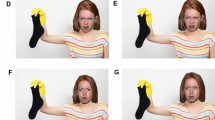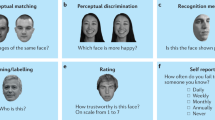Abstract
Sex, age and education differences in facial affect recognition were assessed within a large sample (n = 7,320). Results indicate superior performance by females and younger individuals in the correct identification of facial emotion, with the largest advantage for low intensity expressions. Though there were no demographic differences for identification accuracy on neutral faces, controlling for response biases by males and older individuals to label faces as neutral revealed sex and age differences for these items as well. This finding suggests that inferior facial affect recognition performance by males and older individuals may be driven primarily by instances in which they fail to detect the presence of emotion in facial expressions. Older individuals also demonstrated a greater tendency to label faces with negative emotion choices, while females exhibited a response bias for sad and fear. These response biases have implications for understanding demographic differences in facial affect recognition.


Similar content being viewed by others
Notes
All details pertaining to post-hoc tests are available from the corresponding author upon request.
References
Calder, A. J., Keane, J., Manly, T., Sprengelmeyer, R., Scott, S., Nimmo-Smith, I., et al. (2003). Facial expression recognition across the adult life span. Neuropsychologia. Special Issue: The cognitive neuroscience of social behavior, 41(2), 195–202.
Campbell, R., Elgar, K., Kuntsi, J., Akers, R., Terstegge, J., Coleman, M., et al. (2002). The classification of ‘fear’ from faces is associated with face recognition skill in women. Neuropsychologia, 40(6), 575–584.
Carstensen, L. L., Gross, J. J., & Fung, H. H. (1998). The social context of emotional experience. New York, NY: Springer.
Carstensen, L. L., & Mikels, J. A. (2005). At the intersection of emotion and cognition: Aging and the positivity effect. Current Directions in Psychological Science, 14, 117–121.
Carter, C. S., Barch, D. M., Gur, R., Gur, R., Pinkham, A., & Ochsner, K. (2009). CNTRICS final task selection: Social cognitive and affective neuroscience-based measures. Schizophrenia Bulletin, 35(1), 153–162.
Carton, J. S., Kessler, E. A., & Pape, C. L. (1999). Nonverbal decoding skills and relationship well-being in adults. Journal of Nonverbal Behavior, 23(1), 91–100.
Ciarrochi, J. V., Chan, A. Y. C., & Caputi, P. (2000). A critical evaluation of the emotional intelligence construct. Personality and Individual Differences, 28(3), 539–561.
Darwin, C. (1965). The expression of emotions in man and animals. Chicago: University of Chicago Press.
Elfenbein, H. A., Foo, M. D., White, J., Tan, H. H., & Aik, V. C. (2007). Reading your counterpart: The benefit of emotion recognition accuracy for effectiveness in negotiation. Journal of Nonverbal Behavior, 31(4), 205–223.
Gur, R. C., Sara, R., Hagendoorn, M., Marom, O., Hughett, P., Macy, L., et al. (2002). A method for obtaining 3-dimensional facial expressions and its standardization for use in neurocognitive studies. Journal of Neuroscience Methods, 115(2), 137–143.
Hall, J. A. (1978). Gender effects in decoding nonverbal cues. Psychological Bulletin, 85(4), 845–857.
Hall, J. A. (1984). Nonverbal sex differences: Communication accuracy and expressive style. Baltimore, MD: Johns Hopkins University Press.
Hall, C. W., Gaul, L., & Kent, M. (1999). College students’ perception of facial expressions. Perceptual and Motor Skills, 89(3, Pt 1), 763–770.
Hampson, E., van Anders, S. M., & Mullin, L. I. (2006). A female advantage in the recognition of emotional facial expressions: Test of an evolutionary hypothesis. Evolution and Human Behavior, 27(6), 401–416.
Hess, U., Blairy, S., & Kleck, R. E. (1997). The intensity of emotional facial expressions and decoding accuracy. Journal of Nonverbal Behavior, 21(4), 241–257.
Isaacowitz, D. M., Loeckenhoff, C. E., Lane, R. D., Wright, R., Sechrest, L., Riedel, R., et al. (2007). Age differences in recognition of emotion in lexical stimuli and facial expressions. Psychology and Aging, 22(1), 147–159.
Isaacowitz, D. M., Wadlinger, H. A., Goren, D., & Wilson, H. R. (2006). Selective preference in visual fixation away from negative images in old age? An eye-tracking study. Psychology and Aging, 21, 40–48.
Keightley, M. L., Winocur, G., Burianova, H., Hongwanishkul, D., & Grady, C. L. (2006). Age effects on social cognition: Faces tell a different story. Psychology and Aging, 21(3), 558–572.
Kirouac, G., & Doré, F. Y. (1985). Accuracy of the judgment of facial expression of emotions as a function of sex and level of education. Journal of Nonverbal Behavior, 9(1), 3–7.
Kohler, C. G., Turner, T. H., Bilker, W. B., Brensinger, C. M., Siegel, S. J., Kanes, S. J., et al. (2003). Facial emotion recognition in schizophrenia: Intensity effects and error pattern. American Journal of Psychiatry, 160(10), 1768–1774.
Malatesta, C. Z., Izard, C. E., Culver, C., & Nicolich, M. (1987). Emotion communication skills in young, middle-aged, and older women. Psychology and Aging, 2(2), 193–203.
Mill, A., Allik, J., Realo, A., & Valk, R. (2009). Age-related differences in emotion recognition ability: A cross-sectional study. Emotion, 9(5), 619–630.
Montagne, B., Kessels, R. P. C., Frigerio, E., de Haan, E. H. F., & Perrett, D. I. (2005). Sex differences in the perception of affective facial expressions: Do men really lack emotional sensitivity? Cognitive Processing, 6(2), 136–141.
Moreno, C., Borod, J. C., Welkowitz, J., & Alpert, M. (1993). The perception of facial emotion across the adult life span. Developmental Neuropsychology, 9(3–4), 305–314.
Phillips, L. H., MacLean, R. D. J., & Allen, R. (2002). Age and the understanding of emotions: Neuropsychological and sociocognitive perspectives. Journals of Gerontology. Series B, Psychological Sciences and Social Sciences, 57B(6), 526–530.
Rotter, N. G., & Rotter, G. S. (1988). Sex differences in the encoding and decoding of negative facial emotions. Journal of Nonverbal Behavior, 12(2), 139–148.
Ruffman, T., Henry, J. D., Livingstone, V., & Phillips, L. H. (2008). A meta-analytic review of emotion recognition and aging: Implications for neuropsychological models of aging. Neuroscience and Biobehavioral Reviews, 32(4), 863–881.
Scholten, M. R. M., Aleman, A., Montagne, B., & Kahn, R. S. (2005). Schizophrenia and processing of facial emotions: Sex matters. Schizophrenia Research, 78(1), 61–67.
Sullivan, S., & Ruffman, T. (2004). Emotion recognition deficits in the elderly. International Journal of Neuroscience, 114(3), 403–432.
Wagner, H. L. (1993). On measuring performance in category judgment studies of nonverbal behavior. Journal of Nonverbal Behavior, 17(1), 3–28.
Williams, L. M., Brown, K. J., Palmer, D., Liddell, B. J., Kemp, A. H., Olivieri, G., et al. (2006). The mellow years?: The neural basis of improving emotional stability over age. The Journal of Neuroscience, 26(24), 6422–6430.
Acknowledgments
This project was supported by NIH grants MH60722 and MH64045, and NIMH Post-Doctoral Research Training Grants (MH019112-18) awarded to the first and second authors. We would also like to thank all participants who contributed to this research.
Author information
Authors and Affiliations
Corresponding author
Rights and permissions
About this article
Cite this article
Sasson, N.J., Pinkham, A.E., Richard, J. et al. Controlling for Response Biases Clarifies Sex and Age Differences in Facial Affect Recognition. J Nonverbal Behav 34, 207–221 (2010). https://doi.org/10.1007/s10919-010-0092-z
Published:
Issue Date:
DOI: https://doi.org/10.1007/s10919-010-0092-z




